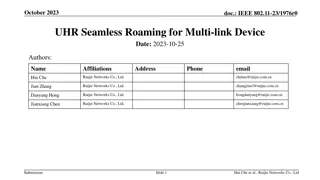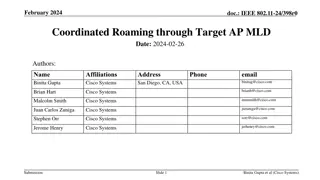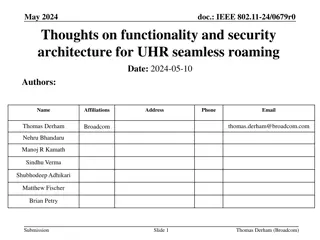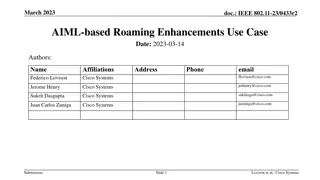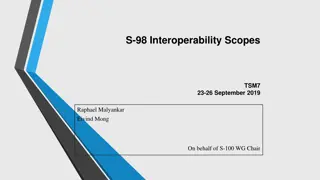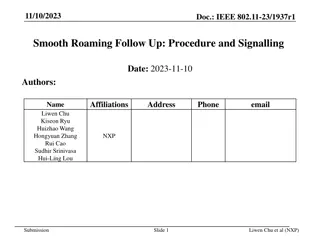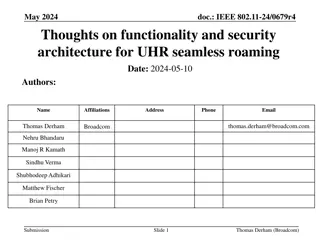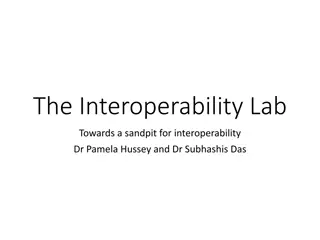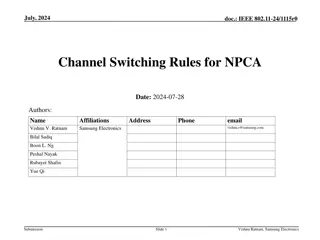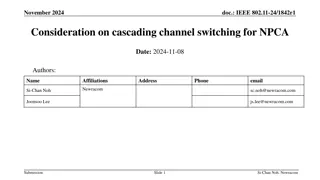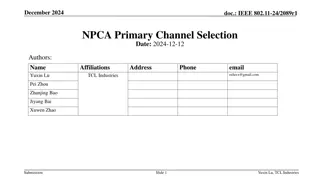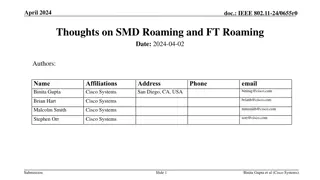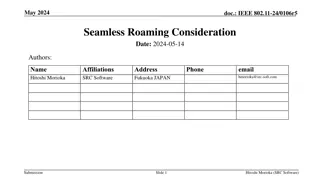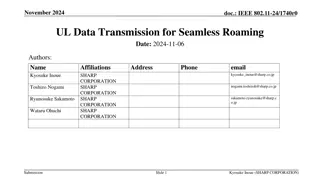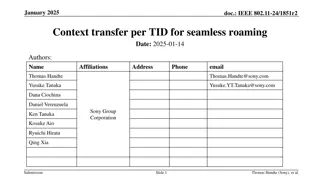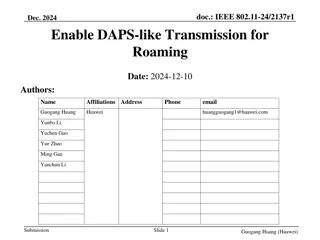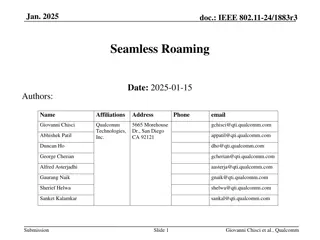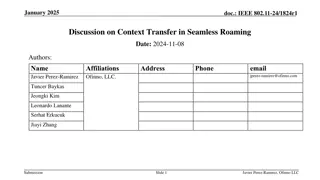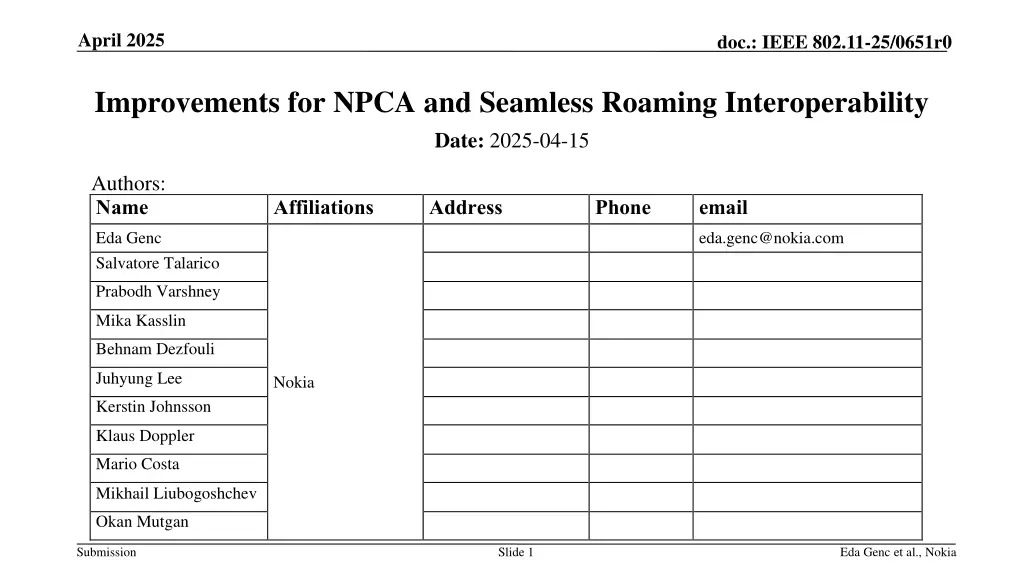
Enhancing IEEE 802.11 Roaming with NPCA and Seamless Interoperability
"Explore improvements in roaming behavior for non-AP Multi-Link Devices (MLDs) with NPCA capability in IEEE 802.11 networks. Addressing challenges and proposing solutions for seamless interoperability during wireless transitions." (Total characters: 241)
Download Presentation

Please find below an Image/Link to download the presentation.
The content on the website is provided AS IS for your information and personal use only. It may not be sold, licensed, or shared on other websites without obtaining consent from the author. If you encounter any issues during the download, it is possible that the publisher has removed the file from their server.
You are allowed to download the files provided on this website for personal or commercial use, subject to the condition that they are used lawfully. All files are the property of their respective owners.
The content on the website is provided AS IS for your information and personal use only. It may not be sold, licensed, or shared on other websites without obtaining consent from the author.
E N D
Presentation Transcript
April 2025 doc.: IEEE 802.11-25/0651r0 Improvements for NPCA and Seamless Roaming Interoperability Date: 2025-04-15 Authors: Name Affiliations Address Phone email Eda Genc Salvatore Talarico eda.genc@nokia.com Prabodh Varshney Mika Kasslin Behnam Dezfouli Juhyung Lee Nokia Kerstin Johnsson Klaus Doppler Mario Costa Mikhail Liubogoshchev Okan Mutgan Submission Slide 1 Eda Genc et al., Nokia
April 2025 doc.: IEEE 802.11-25/0651r0 Reference to Comment Resolution This contributions proposes a resolution for the following comment [7]: 2693Salvatore Talarico 37.8.2.5.2 75.61Roaming procedure should include behavior for NPCA capable non- AP STAs Procedure on how to ensure seamless roaming for an NPCA capable non- AP STA is missing including related information which should be part of the context transfer and STA behaviour. MAC Submission Slide 2 Eda Genc et al., Nokia
April 2025 doc.: IEEE 802.11-25/0651r0 Abstract In this contribution, we discuss the behavior of non-AP Multi-Link Devices (MLDs) during seamless roaming operations when the Non-Primary Channel Access (NPCA) mechanism is concurrently enabled. o Each feature targets independent performance improvements in 802.11 roaming improves mobility, while NPCA enhances spectrum usage under congestion. o However, interoperability challenges exist when these features operate concurrently. Two baseline behavioral approaches are provided together with some additionalmechanisms that aim to improve the robustness and efficiency of roaming under NPCA conditions. The goal is to define a consistent and interoperable behavior for roaming MLDs in NPCA- enabled networks. Submission Slide 3 Eda Genc et al., Nokia
April 2025 doc.: IEEE 802.11-25/0651r0 Introduction Without timely exchange of NPCA-related information, roaming operations may be disrupted by NPCA channel switching, or the target AP may lack awareness of the non-AP MLD s NPCA state or capability [6]. While both features provide benefits, their concurrent operation can lead to undesired behaviors, particularly during link transition phases, e.g., the non-AP MLD may not receive critical management frames, downlink data may be interrupted, the AP may assume the MLD is reachable via NPCA when it's not. In this contribution, we focus on the non-AP MLD behavior and decision logic during roaming, regardless of the NPCA-related information exchange mechanisms. Submission Slide 4 Eda Genc et al., Nokia
April 2025 doc.: IEEE 802.11-25/0651r0 Problem Statement Identified Issues When the two features are concurrently operated, this can lead to disruptions during roaming due to unexpected and non-deterministic switching behavior and also lead to underutilization of resources. Issue 1: Ambiguity in behavior when roaming to AP MLD with different NPCA status or primary channel. Issue 2: A non-AP MLD may roam to a target AP MLD operating on an NPCA primary channel without prior awareness, causing communication gaps. Issue 3: Target AP MLD may not be aware of the non-AP MLD's NPCA capabilities, affecting how it schedules transmissions post-roaming. Submission Slide 5 Eda Genc et al., Nokia
April 2025 doc.: IEEE 802.11-25/0651r0 What Should the Default Behavior Be? (1/2) During seamless roaming preparation or execution, current AP MLD and non-AP MLD may switch to NPCA primary channel based on the switching conditions. In this case, which channel should a STA affiliated with the non-AP MLD use for the link with the target AP MLD? Submission Slide 6 Eda Genc et al., Nokia
April 2025 doc.: IEEE 802.11-25/0651r0 What Should the Default Behavior Be? (2/2) Option 2: Non-AP MLD uses the NPCA decision logic during roaming: 1. If the non-AP STA operates on the NPCA primary, an this is the same for both current and target AP MLDs, it shall follow OBSS NAV from current AP upon roaming. 2. If the non-AP STA operates on the BSS primary, it uses the target AP s primary to decide whether to switch to target NPCA primary. Option 1 (preferred): After non-AP MLD receives the Link Reconfiguration Response (execution), STA affiliated with non-AP MLD shall always switch to the primary channel of the AP affiliated with the target AP MLD to complete seamless roaming, for link setup and data path establishment. Pro: Simple with little spec impact. Cons: Not fully optimized as a non-AP STA may be subject to latencies and communication discontinuities due to possible mismatch in primary used between current and target AP MLDs. Pro: Consistent with NPCA logic. Con: Same as option 1, but enforces a non-AP STA to retain the decision of switching based on inter-BSS transmissions relative to the current AP MLD Submission Slide 7 Eda Genc et al., Nokia
April 2025 doc.: IEEE 802.11-25/0651r0 Handling of NPCA Transitions While Roaming During seamless roaming preparation or execution, target AP MLD may switch to NPCA primary channel due to OBSS detection and non-AP MLD is not aware of this switch. The goal is to define robust STA behavior to handle these transitions Submission Slide 8 Eda Genc et al., Nokia
April 2025 doc.: IEEE 802.11-25/0651r0 Handling of NPCA Transitions While Roaming Option B: Post-Switch NPCA Channel Check Option A: NPCA Status Update Before Roaming Completion Target AP MLD sends its NPCA status (channel, NAV, etc.) to non-AP MLD before roaming is finalized (e.g., Link reconfiguration response) Can be done reactively (at roam request) or periodically (status update). Ensures accurate context for roaming behavior. Pro: Improves decision-making by informing the STA of NPCA state early. Con: Depends on timely and reliable signaling from the target AP. Option C: RU index-based Detection If both current AP s primary and NPCA primary overlap with target AP s NPCA bandwidth, Non-AP MLD may detect a wideband transmission from the target. STA extracts RU index to infer channel activity and target AP state. Pro: Passive method that requires no additional signaling. Con: Limited to overlapping channels and may not apply universally. Non-AP MLD switches to target AP s primary channel. If no OBSS detected and AP not heard, the STA: Optionally switches to target s NPCA primary to probe for activity, Optionally, if low-latency traffic is pending for the non- AP MLD, the target AP MLD may send NPCA Initial Control Frames (ICFs) periodically in its NPCA primary channel, and/or repeat them until a transmission from the non-AP MLD is received. Pro: Enables discovery of target AP activity even if it's on the NPCA channel. Con: Further implementation required. Less efficient due to switching delays associated to it. Submission Slide 9 Eda Genc et al., Nokia
April 2025 doc.: IEEE 802.11-25/0651r0 Conclusions Seamless roaming and NPCA mechanisms can be operated concurrently and a baseline behavior from a non-AP STA point of view is needed to define in which particular primary channel a non-AP STA shall operate upon roaming. We proposed two options for a baseline behavior and we also discuss further options on how to more optimally handle the NPCA transitions while roaming. Submission Slide 10 Eda Genc et al., Nokia
April 2025 doc.: IEEE 802.11-25/0651r0 Straw Polls SP1: Do you agree that upon roaming a STA affiliated with a non-AP MLD shall always switch to the primary channel of the AP affiliated with the target AP MLD for link setup and data path establishment with the AP affiliated with the target AP MLD (Option 1)? Submission Slide 11 Eda Genc et al., Nokia
April 2025 doc.: IEEE 802.11-25/0651r0 Straw Polls SP2: Do you agree that further mechanisms are needed to properly handle the case when while the current AP MLD operates on the primary channel, the target AP MLD has switched to the NPCA primary channel and vice versa? Submission Slide 12 Eda Genc et al., Nokia
April 2025 doc.: IEEE 802.11-25/0651r0 References [1] PDT MAC Seamless Roaming, IEEE 802.11-25/0566r0. [2] PDT MAC NPCA, IEEE 802.11-24/1762r23. [3] TGbn Motion List - Part 1, v26. [4] TGbn Motion List - Part 2, v14. [5] IEEE P802.11bn /D0.2. [6] Thoughts on Seamless Roaming and NPCA , Ning Gao (Oppo). [7] IEEE 802.11bn CC50 comments on D0.1, IEEE 802.11-25/0296r17. Submission Slide 13 Eda Genc et al., Nokia

